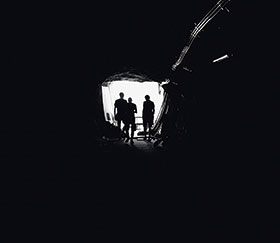

A number of challenges face the mining sector in South Africa. Apart from the economic pressure brought to bear on operations by strongly fluctuating commodity prices, profitability is being rapidly eroded by predominantly syndicated theft of resources. Hi-Tech Security Solutions discusses the role of security technology and physical guarding in the ongoing battle to retain control of assets.

Nash Lutchman, senior vice president of protection services at Sibanye Gold, outlines a rather challenging landscape for mining houses. He says that, in general the cost to company involved in funding adequate security solutions is often viewed as a grudge purchase and a cost driver. However, against the bleak criminal landscape in which the mining industry has to operate in within South Africa, this view is increasingly being replaced by one where security spend is seen as investing in the future of the industry.
The apparent difficulty experienced by organs of the state to effectively deal with crime has resulted in the industry having to allocate significant spend on security. The situation is further exacerbated by the many examples of syndicates performing high profile crimes that are simply not brought to book. This leaves mining houses, and in fact the industry in general, with no option but to develop in-house security capability, at a huge cost, and/or to secure the services of the private security industry in order to minimise the effects of crime.
Understandably, mining operations are functioning against a chaotic background. Soughtafter commodities prove an irresistible carrot to crime syndicates, who have spent many years honing their skills. The result is that there is no other industry that has such a well-developed footprint of syndicated crime as the commodities industry. Commonly recognised not only as raw material, but also as a form of currency, commodities continue to attract increasingly sophisticated attacks from syndicates.
Combatting these crimes is cyclical, says Lutchman. Since the syndicates operate with impunity, this leaves the mines at a disadvantage. Lutchman says that while the laws regulating the handling of commodities is adequate, it is the policing process which is flawed. He advocates the use of specialised police units to deal with this market sector. This he claims, is essential, given the concentrated and specialised nature of the syndicates targeting commodities.
A team effort
Foremost, these policing units need to take cognisance of the fact that syndicates are a team endeavour that comprise, amongst others, corrupt mine employees, external and internal security employees and some members of the SAPS and other relevant government structures. Tackling and reducing their efforts therefore requires the formation of concerted and committed commodities anti-crime teams.
Due to the fact that the SAPS is under-resourced and inadequately trained in terms of commodities crime prevention and investigation, mines need to unfortunately, and unnecessarily, create a security sector that protects assets and make business unattractive to criminals.
Since there is such a large number of people involved in the private security sector, there is an increased risk attached to the integrity of these employees. While PSiRA is methodically ploughing its way through a backlog of applications for certification, unfortunately too many security personnel with dubious records are slipping through the cracks. Lutchman says that two predominant factors drive collusion with syndicates – greed and dissatisfaction with remuneration. Add to these the very apparent threat to life and limb of employees and their families if cooperation is not promised.
Human-technology balance

Gerhard Furter, research and development manager at InfinIT, says that the rub is that the mines are not only governed by their own policies and those of the Department of Mineral Resources, but furthermore by union intervention. This poses a very real challenge to mine operators who need to find a balance between complete automation and having too many guards. Many mine operators would prefer to follow the technology route because of collusion with syndicates and the issues deriving from improperly trained security guards. However, budget is the biggest problem with regard to technology and has a direct influence on the ratio of technology to guards.
Lutchman cautions that technology on its own is not enough. “It is all very well having cameras providing extensive surveillance around the premises, but can the camera apprehend criminals? Security guards or reaction teams are required to react to events by apprehending perpetrators and ensuring that a chain of evidence is followed.”
Sibanye Gold manages its security in layers, with in-house employees and contractors. Lutchman emphasises that mines need management structures in place to ensure compliance with regulations and legislation. The security division within Sibanye has adopted a hierarchical structure due to the regulatory nature of security, and all personnel are aware of and acknowledge their specific responsibilities. Managers are responsible for putting the values and strategies in place and ensuring that security is delivered at an operational level in terms of the security risk and threat profile specific to a mining operation.
People, process, technology

Security should always revolve around people, technology and processes says Ian Downie, director at Xone Integrated Security. When dealing with the mining environment, a complex set of processes are required to ensure the effective operation of the mine, with a variety of resources fulfilling synergistic tasks.
Downie says a command and control environment, typically consisting of multi-tier control rooms, is by far the most important tool at the disposal of a mine. This is a highly sophisticated environment, requiring specialist staff, strong management, detailed process development, and integration of multiple disparate systems. This should result in a scenario where management of the day to day activities is manageable, efficient and measurable. Emergency initiatives can be dealt with reliably and intelligence gathering co-ordinated.
He suggests the implementation of a strong investigations component, a multi-tier control room, manpower tracking, maintenance tracking and management systems. These will then link to technology such as CCTV, X-ray screening machines, fire detection systems, video analytics, access control, radar, drones, electric fencing and other aligned systems. Unfortunately, these elements often operate in silos, making the entire operation less efficient than one would encounter if they are all viewed in an holistic manner.
Recent protests in the educational sector over the retention of outsourced labour are having ripple effects in the entire industry, with murmurings of its impact on the security sector in the mining industry.
Where mines use only outsourced personnel and contractors, it is critical that they employ an internal coordinator and that a comprehensive service level agreement (SLA) is in place to protect the mine from any liability. Where hybrid or in-house models are used, the liability becomes a shared responsibility in the first instance and entirely mine-based in the second instance.
According to Lutchman, outsourcing has a number of attractions, given ongoing strike action by the unionised permanent labour component. In addition, the assumption is that outsourced security guards employed by reputable security providers have been trained to certain minimum requirements. Finally, there is a major cost saving element in relation to common company benefits such as pension/provident funds, medical aid, bonuses and security equipment. Allied to this is the need for a smaller human resources component due to the fact that there are fewer full-time employees.
The downside to outsourced labour is that there are often issues with regard to endemic inefficiencies and corruption, as well as the question of whether the security personnel are trained with applicability to the mining industry in mind. In addition, it is difficult to ensure that the security guard has the right personality and temperament for the task at hand. Typically a guard providing security at a shopping mall is faced with different challenges when providing security at a mine.
Non-standard employees
This could all become a moot issue in the future, however, due to the fact that labour law is changing as a result of increasing pressure from Cosatu and other unions. The Labour Relations Amendment Act came into operation on 1 January 2015 and places significant restrictions on the use of ‘non-standard’ employees, including fixed term and part time contracts. This will therefore over time likely result in the replacement of outsourced security services with more insourced personnel.
As a result of the rampant crime rates, Sibanye Gold has had to widen its security coverage, using a hybrid model that incorporates both outsourced and insourced security personnel. The in-house component is primarily employed in what are deemed by Sibanye Gold to be high risk areas, particularly where commodities are being handled and processed. Instances where the company is partnering with outsourced specialists includes the perimeter security and access control on the perimeter. Overall management of all areas in the security portfolio is handled internally by a well-trained and experienced team.
Furter says that the degree of outsourcing depends on the mining company, with the larger ones tending to recruit and train security personnel internally, then using external consultants for highly specialised work. Since it is difficult to maintain requisite standards with outsourced personnel, many mining operations use their own employees and police them internally.
Downie adds that often the bulk of technology and security staff provision is outsourced but in many instances the various divisions will have an insource provision. Ultimately the choice depends on who is driving the security contract.
Chasing technology
Technology, Furter believes, is key to managing security, with perimeter fencing and surveillance predominating. X-ray and scanning technology is becoming increasingly popular for perimeter security, with the fundamental purpose of deterring and detecting. He says that the company is currently implementing facial recognition at large gatherings, specifically where labour strike action is taking place. This will allow mining operations to identify troublemakers, add them to a database and ensure that they are quickly identified and apprehended in the future. Another area where technology is coming to the fore in theft prevention, is the use of biometrics to pick up user duress.
He has a number of suggestions that will provide a more effective security landscape. Firstly, he believes that restrictions around the use of mobile technology needs to be softened. Secondly, he feels that there should be a call for a standards committee around security installations on mines. While the Department of Mineral Resources calls for specific standards for security companies working on mines, security installations do not, in many instances, meet a similar quality standard. The implementation of a governing body with compulsory registration would therefore determine a certain minimum standard of security installation and operation on mines.
Lutchman points out that Sibanye chases after technology and in line with this approach it has developed a comprehensive security technology strategy. Security technology in fact underpins the mine’s entire operational security strategy, with CCTV, seismic and thermal technology providing an early warning system. As an example of security innovation at work, the company has installed a number of seismic sensors around its electrical sub stations.
The use of drones on mines is an interesting topic, but limitations placed on operators and the sheer cost of operating a drone, are often stumbling blocks to their implementation. Amongst other things, but certainly the most important factor, is that one needs to have a CAA approved and valid remote pilot licence as well as a letter of approval to operate the drone.
Lutchman says that the company has used drones intermittently in the past through an accredited service provider and is currently investigating the possibility of making it part of their in-house operation due to the fact that it is an innovative and fast way of getting ‘eyes in the air’, while working in tandem with an efficient ground-based reaction team.
Downie states that as we are moving into the virtual world almost every device has some form of built-in intelligence, allowing the ability for the mining environment to be more operationally productive in terms of reliability, coverage, reduced manpower and automated triggering of response. This therefore results in far more efficiency of processes to take place through a complex landscape.
He says that as a result, a primary area of focus is the implementation of a command and control centre, which affords the ability to manage the huge amounts of data that occur with increasing technology adoption. Too many devices, views and overload of information mean that traditional security environments no longer function efficiently. To achieve this efficiency, a high-level control room with very carefully mapped out customised integration of all these systems, driven by an incident management system and specialist staff, is essential. Management by exception is the ideal for any mine.
Central management
Centralised security in the mining environment can only be fully functional and effectively managed through the use of a central management platform. Physical Security Information Management (PSIM), Furter says, should be an element in every mine manager’s arsenal. However, it is advised to take cognisance of the fact that it is complex and takes a long time to implement.
Downie adds that the core of any risk programme needs to be the ability to collect information, log it, track it and then generate meaningful reports. With this ability one can understand how efficient one’s operation is and then work towards improving the results to a satisfactory level. The risk programme should also allow automated notification when teams are performing in a sub-standard manner, and provide more certainty in terms of response to emergencies.
Effective security programmes should increase workflow and the correlation of data to the correct parties. The security programme should furthermore perform a variety of functions that include checking of compliance with corporate governance, tracking of standards, logging and management of incidents, automated workflow, integration of systems and powerful customised reporting.
It is essential that a balanced combination of technology and physical guarding is used to ensure that all aspects, from monitoring and detection, through to reaction, apprehension and prosecution, are effectively managed. In general, the mining industry is now seeing that security is an investment rather than as a cost.

© Technews Publishing (Pty) Ltd. | All Rights Reserved.